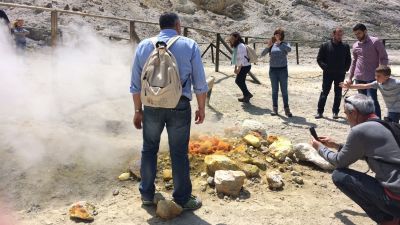Campi Flegrei: The volcano that may have killed off Neanderthals is 'restless' again

A volcanic field in Italy that last erupted nearly 500 years ago appears to be on the brink of blowing again, scientists say.
At least half a million people live on the sprawling volcanic field named the Campi Flegrei - known as the 'Phlegraean' fields in Greek or 'burning' fields in English
The Campi Flegrei are a constellation of ancient volcanic centres near densely populated Naples, Italy's third-largest city, and far more active than Mount Vesuvius, which buried the Ancient Roman city of Pompeii in AD 79.
Its spectacular boiling mud and sulphurous steam vents attract tourists from around the world.
But scientists have been keeping a close eye on the fields since the 1950s, when swarms of earthquakes began stirring fears of unrest.
Camp Flegrei's last minor, but notable, eruption occurred in 1538, but scientists have recorded thousands of earthquakes in a 'restless' period since about 1950.
The 16th-century event took place after an interval of about 3,000 years, but previous intervals have been as short as decades or centuries.
A return to eruption after an interval of half a century is a "realistic possibility," scientists writing in the Communications Earth & Environment journal this month have warned.
The article explains that volcanoes awakening after a long restful period must rupture the crust before magma can erupt.
That rupture is often foreshadowed by increasing numbers of earthquakes and changes to a volcano's crust.
Scientists say a change in the number of local earthquakes and to the structure of Campi Flegrei's crust, including ground uplift at its caldera, signal that a rupturing sequence has been developing.
A 'caldera' is a cauldron-like hollow formed by an inward collapse during a previous volcanic event, whereas a 'crater' is formed from an explosion of rocks and other materials outwards during an eruption.
Campi Flegrei takes the form of sprawling fields, rather than the classic conical volcanic shape - it is a caldera similar to the Yellowstone National Park in the US.
And at about 12–15 km across, it is the largest active caldera in Europe.
The field includes the Solfatara crater, the mythological home of the Roman god of fire, Vulcan.
The fields extend west from the outskirts of Naples, a city with a population of nearly 2.2 million, to the Tyrrhenian Sea.About a third of Campi Flegrei is partially submerged beneath the Bay of Pozzuoli, the remaining two-thirds are home to more than 360,000 people.
A rupturing sequence at Campi Flegrei had previously been observed in 1950-1952, 1969-1972, 1982-1984 and since 2004, the journal article says.
The scientists predicted in 2016 that an approach to rupture would continue after an additional uplift of 30-40 cm at the location where the largest movement had been documented.
Four episodes of uplift have already raised part of Pozzuoli by more than four metres, and twice triggered evacuations of around 40,000 people, the researchers noted.
The fourth uplift has been continuing since 2005 at an average of 0.01–0.1m a year, which scientists believe has been caused by magmatic gas accumulating about 3 km below the surface, slowly rupturing the volcano's crust.
According to The Guardian, around 500,000 people live in an area around the volcano that Italy’s civil protection agency has designated the 'red zone' - the area at highest risk.
Another 800,000 people live in the 'yellow' zone, which covers the entire coastal town of Pozzuoli.
Did Campi Flegrei kill off the Neanderthals?
One of Campi Flegrei's huge eruptions around 39,000 years ago is believed to have contributed to the extinction of the Neanderthals.
The winter that followed the huge eruption is believed by some researchers to have partly driven the Neanderthals' extinction, ushering in the time of Homo Sapiens.
But some researchers dispute the claim Campi Flegrei's eruption was the final blow for the Neanderthals, whose sudden and steep disappearance remains shrouded in mystery.
Some theories say competition from the arrival of modern humans in Europe could have played a role in the demise of the Neanderthals.
Want a quick and expert briefing on the biggest news stories? Listen to our latest podcasts to find out What You Need To Know...